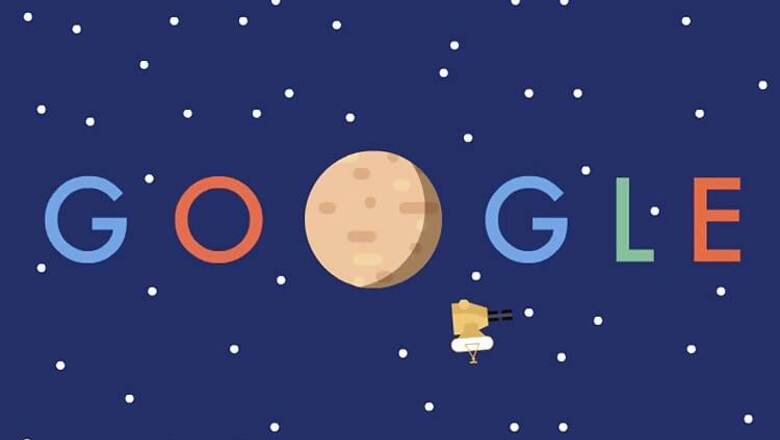
views
New Delhi: Although Pluto’s status has changed from a planet to a mere dwarf, this ball of rock and ice nonetheless holds great significance in planetary studies.
For the first time, NASA is getting to witness a close peek at Pluto which is orbiting at the furthest edge of our solar system. Honouring the achievement, Google’s new animated Pluto doodle shows the scientific breakthrough.
The doodle has been created by Kevin Laughlin and is visible on Google’s homepages across the globe.

On Tuesday, NASA's New Horizons spacecraft will sweep past Pluto and present the previously unexplored world in all its icy glory.
It promises to be the biggest planetary unveiling in a quarter-century. The curtain hasn't been pulled back like this since NASA's Voyager 2 shed light on Neptune in 1989.
Now it's little Pluto's turn to shine way out on the frigid fringes of our solar system.
New Horizons has traveled 3 billion miles (4.8 billion kilometers) over 9½ years to get to this historic point. The fastest spacecraft ever launched, it carries the most powerful suite of science instruments ever sent on a scouting and reconnaissance mission of a new, unfamiliar world.
The size of a baby grand piano, the spacecraft will come closest to Pluto on Tuesday morning — at 5:19 PM IST (1149 GMT). That's when New Horizons is predicted to pass within 7,767 miles (12,500 kilometers) of Pluto. Fourteen minutes later, the spacecraft will zoom within 17,931 miles (28,856 kilometers) of Charon, Pluto's jumbo moon.
It is the last stop in NASA's quest to explore every planet in our solar system, starting with Venus in 1962. And in a cosmic coincidence, the Pluto visit falls on the 50th anniversary of the first-ever flyby of Mars, by Mariner 4.
Yes, we all know Pluto is no longer an official planet, merely a dwarf, but it still enjoyed full planet status when New Horizons rocketed from Cape Canaveral, Florida, on Jan. 19, 2006. Pluto's demotion came just seven months later, a sore subject still for many.
The Hubble Space Telescope previously captured the best pictures of Pluto. If the pixelated blobs of pictures had been of Earth, though, not even the continents would have been visible.
An image released last week shows a copper-colored Pluto bearing, a large, bright spot in the shape of a heart.
Scientists expect image resolution to improve dramatically by Tuesday.
New Horizons, weighing less than 1,000 pounds (450 kilograms) including fuel, has seven instruments that will be going full force during the encounter. It's expected to collect 5,000 times as much data, for instance, as Mariner 4.
Pluto is the only planet in the solar system to be discovered by an American. It is actually is a mini solar system unto itself. Pluto — just two-thirds the size of our own moon — has big moon Charon that's just over half its size, as well as baby moons Styx, Nix, Hydra, Kerberos and Styx. The names are associated with the underworld in which the mythological god, Pluto, reigned. New Horizons will observe each known moon and keep a lookout for more.
Scientists involved in the $700 million effort want to get a good look at Pluto and Charon, and get a handle on their surfaces and chemical composition. They also plan to measure the temperature and pressure in Pluto's nitrogen-rich atmosphere and determine how much gas is escaping into space. Temperatures can plunge to nearly minus-400 degrees Fahrenheit.
Pluto has tantalized astronomers since its 1930 discovery by Clyde Tombaugh using the Lowell Observatory in Flagstaff, Arizona. Some of Tombaugh's ashes are aboard New Horizons. His two children, now in their 70s, plan to be at Johns Hopkins for the encounter.
With its tilted, elongated 248-year orbit, Pluto has made it only a third of the way around the sun since its discovery. The amount of sunlight that reaches Pluto is so dim that at high noon it looks like twilight here on Earth. The massive surrounding Kuiper Belt, in fact, is called the Twilight Zone. The New Horizons team has its eyes on a few much smaller objects in the Kuiper Belt, and is hoping for a mission extension as the spacecraft continues toward the solar system exit on the heels of NASA's Voyagers 1 and 2 and Pioneers 10 and 11.
For now, signals take 4½ hours to travel one-way between New Horizons and flight controllers in Maryland.
New Horizons' science instruments will be cranked up to collect maximum data Tuesday, leaving no time to send back data. In fact, scientists won't be absolutely certain of success until Tuesday night, 13 hours following New Horizons' closest approach, when it "phones home."
It will be Wednesday before the closest of Pluto's close-ups are available for release. And it will be well into next year — October 2016 — before all the anticipated data are transmitted to Earth.
With inputs from AP




















Comments
0 comment